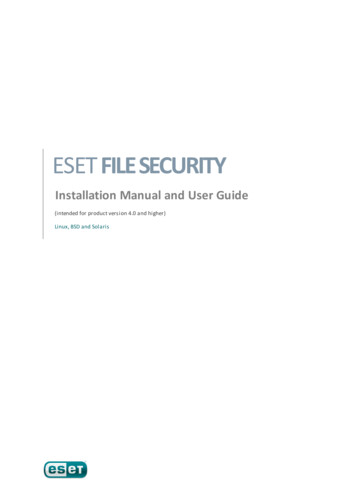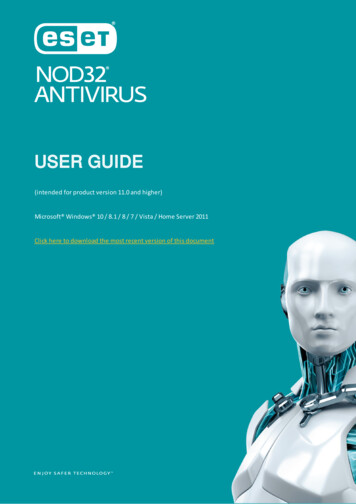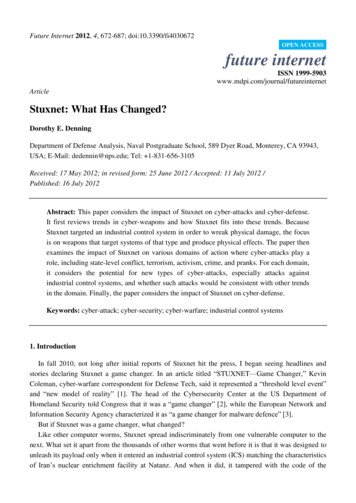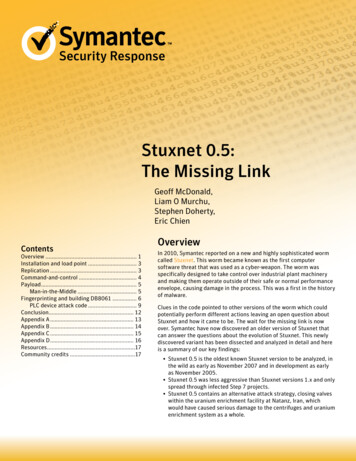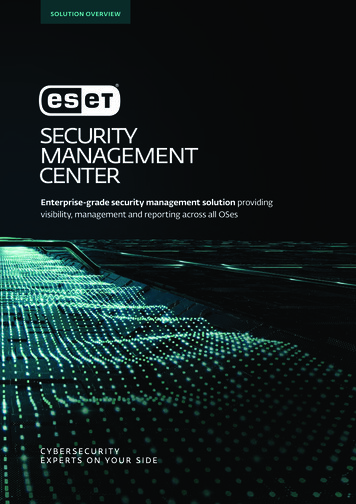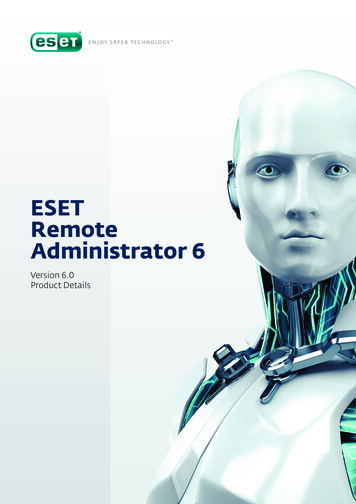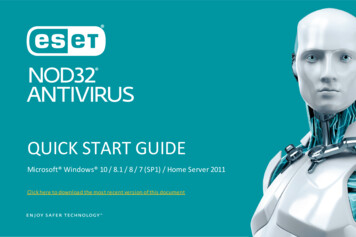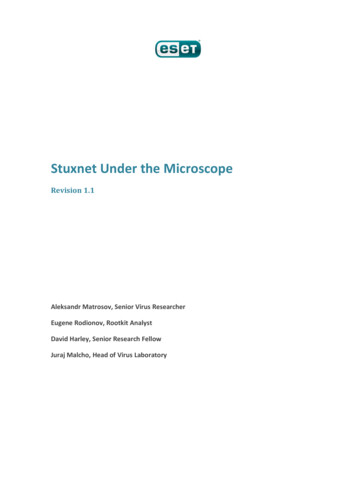
Transcription
Stuxnet Under the MicroscopeRevision 1.1Aleksandr Matrosov, Senior Virus ResearcherEugene Rodionov, Rootkit AnalystDavid Harley, Senior Research FellowJuraj Malcho, Head of Virus Laboratory
2ContentsPREFACE . 41INTRODUCTION . 51.1TARGETED ATTACKS . 51.2STUXNET VERSUS AURORA . 71.3STUXNET REVEALED. 111.4STATISTICS ON THE SPREAD OF THE STUXNET WORM . 152MICROSOFT, MALWARE AND THE MEDIA . 172.1SCADA, SIEMENS AND STUXNET . 172.2STUXNET TIMELINE. 183DISTRIBUTION . 213.13.1.1Propagation via External Storage Devices . 243.1.2Metasploit and WebDAV Exploit . 243.1.3What Do DLL Hijacking Flaws and the LNK Exploit have in Common? . 243.2LNK VULNERABILITY IN STUXNET . 263.3THE MS10-061 ATTACK VECTOR. 283.4NETWORK SHARED FOLDERS AND RPC VULNERABILITY (MS08-067) . 313.50-DAY IN WIN32K.SYS (MS10-073) . 323.64THE LNK EXPLOIT . 21EXPLOITING UNPATCHED 0-DAY IN TASK SCHEDULER. 37STUXNET IMPLEMENTATION . 384.1USER-MODE FUNCTIONALITY . 384.1.1Overview of the main module . 384.1.2Injecting code . 394.1.3Injecting into a current process . 394.1.4Injecting into a new process . 424.1.5Installation . 424.1.6Exported functions. 444.1.7RPC Server . 48www.eset.com
34.1.84.2Resources . 50KERNEL-MODE FUNCTIONALITY . 504.2.1MRXCLS.sys. 524.2.2MRXNET.sys . 564.3STUXNET BOT CONFIGURATION DATA . 574.4REMOTE COMMUNICATION PROTOCOL . 58CONCLUSION . 62APPENDIX A. 63APPENDIX B . 65APPENDIX C . 66www.eset.com
4PrefaceThis report is devoted to the analysis of the notorious Stuxnet worm (Win32/Stuxnet) that suddenlyattracted the attention of virus researchers this summer. This report is primarily intended to describetargeted and semi-targeted attacks, and how they are implemented, focusing mainly on the mostrecent, namely Stuxnet. This attack is, however, compared to the Aurora attack, outlining the similaritiesand differences between the two attacks.The paper is structured as follows. In the first section we introduce the targeted attacks and theircommon characteristics and goals. In this section we present comparison of two attacks: Stuxnet vs.Aurora. The second section contains some general information on SCADA (Supervisory Control And DataAcquisition) systems and PLCs (Programmable Logic Controllers) as Stuxnet’s primary targets of. Thethird section covers the distribution of the Stuxnet worm. Here we describe vulnerabilities that itexploits to infect the target machine. The next section describes the implementation of Stuxnet: usermode and kernel-mode components, RPC Server and their interconnection. We also describe theremote communication protocol that it uses to communicate with the remote C&C.www.eset.com
51 IntroductionRecently, there has been increased public awareness and information about targeted attacks as thenumber of such attacks has significantly increased, becoming a separate cybercriminal business sector inits own right.Many companies are reluctant to disclose information about attempted or successful targeted attacksfor fear of public relations issues affecting their profits, so the information made available to the publiconly represents a small part of what is actually happening.1.1Targeted AttacksAll targeted attacks can be divided into two major classes: Targeting a specific company or organization - this type of attack is directed at a specificorganization and the aim of an intruder is unauthorized access to confidential information suchas commercial secrets (as with the Aurora attack). Targeting specific software or IT infrastructure - this type of attack is not directed at aspecific company and its target is the data associated with a certain kind of software, forexample -banking client software or SCADA systems. Such attacks have to be implemented in amore flexible manner. This class of attacks can do much more damage to a great number ofcompanies than the attacks of the first class. As this class pre-supposes a long term attack, it isdesigned to circumvent protection systems (as with the Stuxnet attack).The most common vector for the development of targeted external attacks is now considered to be theexploitation of vulnerabilities in popular client-side applications (browsers, plugins and so on). Attackerstypically use combinations of multiple steps, which allow them to take root on the client-side. In mostcases the first stage of the attack employs social engineering to allow an attacker to lure the victim to afavorable environment for the implementation of the next attack phase.Figure 1.1 – Typical Stages of Client-Side Attackwww.eset.com
6Bypassing the security software installed in certain organizations is a crucial objective for most malware.There is a separate cybercriminal business sector devoted to providing the means for malicious softwareto stay undetected by specific or widely spread antivirus products.Figure 1.2 – Custom Malware ProtectorThis kind of service can extend the life of outdated malware, or extend the time new threats stayundetected. However, the use of such technologies to resist detection by antivirus software can be usedas a heuristic for the detection of previously unknown samples. But the converse case also holds true:avoiding using any techniques aimed at bypassing antivirus software and making the program resemblelegitimate software more closely can be a way of protecting malware. This is the case with the attackmechanism used by the Stuxnet worm.The Stuxnet attack constituted a serious threat to trust in software using legal digital signatures. Thiscreates a problem for white-listing, where security software is based on the a priori assumption that atrusted program meets certain conditions and is therefore indeed trustworthy. And what if the programclosely resembles legitimate software and even has digital certificates for installed modules published inthe name of reputable companies? All this suggests that targeted attacks could persist much longer overtime than we previously imagined. Stuxnet was able to stay undetected for a substantial period whereno one saw anything suspicious. The use of a self-launching, 0-day vulnerability in the attack allowed therapid distribution of Stuxnet in the targeted region. The choice of this kind of vulnerability is quitedeliberate, because in the absence of information about its existence, use of the exploit will not bedetected. All these facts suggest a well-planned attack which remained unnoticed until long after it waslaunched. But it is precisely the existence of such threats that inspires us to look at the new vector andthe possibility of attacks that use it, in order to reduce the impact of future attacks.www.eset.com
71.2Stuxnet versus AuroraIn the past year, the public has become aware of two targeted attacks, codenamed Stuxnet and Aurora.Both of these attacks have some common features that characterize recent trends in targeted attacks.Nowadays, the most popular vector of penetration of the user’s machine is realized through popularclient-side applications (browsers, plugins and other apps). It is much easier to steal data by launchingan indirect attack on people with access to important information via a malicious web site, than it is toattack the company’s well-protected database server directly. The use of client-side applications as avector of attack is undoubtedly expected by cautious system users and administrators, but this attackmethodology is less predictable and harder to protect against, since in everyday life we use manyapplications, each of them potentially an attack vector.The Aurora and Stuxnet attacks used 0-day exploits to install malicious programs onto the system. Table1.2.1 presents data on the malicious programs and exploits used:Table 1.2.1 – Malicious Software and Exploits Used to Perform AttacksCharacteristicsExploitation vectorAuroraStuxnetMS10-002 (0-day)MS10-046 (0-day)MS10-061 (0-day)MS08-067 (patched)0-day (unpatched)Targeted malicious programWin32/VedrioWin32/StuxnetTable 1.2.2 displays the characteristics of vulnerable platform and exploits, and indicates how seriouslythe intruders take their attacks.www.eset.com
8Table 1.2.2 – Platforms Vulnerable to 0-Day Attack (unpatched)Vulnerable versionsall versions of MSInternet Explorer(6, 7, 8)all versions of MSWindows (WinXP,Vista, 7, )all versions of MSWindows (WinXP,Vista, 7, )WinXP andWin2000Layered shellcodeyesnonoyesRemote attacksyesyesyes (only forWinXP)noOther vectorsnoyesyesnoThe exploit ESET detects as JS/Exploit.CVE-2010-0249 (MS10-002) has a narrower range of possiblevectors of distribution than LNK/Exploit.CVE-2010-2568 (MS10-046). The range of vulnerabilities used inthe Stuxnet attack have other interesting features making use of such infection vectors as removableflash drives and other USB devices, and resources shared over the network. The exploit LNK/Exploit.CVE2010-2568 is by its nature so designed that detection of the exploit’s malicious activity is impossible, ifyou are not aware of its existence. If we compare the features of these two exploits, it seems thatJS/Exploit.CVE-2010-0249 is designed for a surprise attack, while in the case of LNK/Exploit.CVE-20102568 a long-term, persistent attack was intended. An additional propagation vector (MS10-061) canspread rapidly within the local network. These observations confirm the data from Table 1.2.3, whichcompares the characteristics of the malicious programs used in these attacks.www.eset.com
9Table 1.2.3 – Comparison of attacksCharacteristicsAuroraStuxnetTargeted group of specificcompaniesSites using SCADA systems butpromiscuous disseminationnoyesdownload in process infectingall in one malwareCode packingyesyesCode obfuscationyesyesAnti-AV functionalityyesyesMasking under legal programsyesyesmodularmodularEstablishing a backdooryesnoDistributed C&CyesnoCommunications protocolhttpshttpCustom encryption ofcommunications protocolyesyesModules with a legal digitalsignaturenoyesUpdate mechanismyes; downloads and runs thedownloaded module viaWinAPIyes; downloads updates viaWinAPI functions and runsthem in memory, withoutcreating any filesUninstall mechanismnoyesInfection counternoyesAvailability of any modificationsmalicious programnoyesTargetMultiple distribution vectorsPayloadArchitecture of maliciousprogramThese two attacks have shown us that no information system is absolutely secure and carefully plannedtargeted or even semi-targeted attacks put a serious weapon into the hands of bad guys. In the case ofStuxnet there are still a lot of open questions, in our report we try to highlight the technical componentof this semi-targeted attack. Stuxnet showed us by example how much can be conceived and achievedusing massive semi-targeted attacks.www.eset.com
10Why semi-targeted? While the payload is plainly focused on SCADA systems, the malware’s propagationis promiscuous. Criminal (and nation-state funded) malware developers have generally moved awayfrom the use of self-replicating malware towards Trojans spread by other means (spammed URLs, PDFsand Microsoft Office documents compromised with 0-day exploits, and so on). Once self-replicatingcode is released, it’s difficult to exercise complete control over where it goes, what it does, and how farit spreads (which is one of the reasons reputable researchers have always been opposed to the use of“good” viruses and worms: for the bad guys, it also has the disadvantage that as malware becomesmore prevalent and therefore more visible, its usefulness in terms of payload delivery is depleted bypublic awareness and the wider availability of protection).As we describe elsewhere in this document, there were probably a number of participants in theStuxnet development project who may have very different backgrounds. However, some of the codelooks as if it originated with a "regular" software developer with extensive knowledge of SCADA systemsand/or Siemens control systems, rather than with the criminal gangs responsible for most malcode, oreven the freelance hacker groups, sometimes thought to be funded by governments and the military,(for example Wicked Rose) we often associate with targeted attacks. However, it’s feasible that whatwe’re seeing here is the work of a more formally-constituted, multi-disciplinary “tiger team”. Suchofficially but unpublicized collaborations, resembling the cooperative work with other agencies thatanti-malware researchers sometimes engage in, might be more common than we are actually aware.On the other hand, the nature of the .LNK vulnerability means that even though the mechanism isdifferent to the Autorun mechanism exploited by so much malware in recent years, its use for deliverythrough USB devices, removable media, and network shares, has resulted in wide enough propagationto prevent the malware from remaining “below the radar”. This may signify misjudgement on the part ofa development team that nevertheless succeeded in putting together a sophisticated collaborativeproject, or a miscommunication at some point in the development process. On the other hand, it maysimply mean that the group was familiar enough with the modus operandi characteristic of SCADA sitesto gamble on the likelihood that Stuxnet would hit enough poorly-defended, poorly-patched and poorlyregulated PLCs to gain them the information and control they wanted. Since at the time of writing it hasbeen reported by various sources that some 14 or 15 SCADA sites have been directly affected by theinfection of PLCs (Programmable Logic Controllers), the latter proposition may have some validity. Whilethe use of these vectors has increased the visibility of the threat, it’s likely that it has also enabled accessto sites where “air-gapped” generic defences were prioritized over automated technical defences likeanti-virus, and less automated system updating and patching. This is not a minor consideration, sincethe withdrawal of support from Windows versions earlier than Windows XP SP3. At the same time, it’sclear that there are difficulties for some sites where protective measures may involve taking criticalsystems offline. While there are obvious concerns here concerning SPoFs (single points of failure), thepotential problems associated with fixing such issues retrospectively should not be underestimated.www.eset.com
111.3Stuxnet RevealedDuring our research, we have been constantly finding evidence confirming that the Stuxnet attack wascarefully prepared. Timestamp in the file wtr4141.tmp indicates that the date of compilation was03/02/2010.Figure 1.3 – Header Information from wtr4141.tmpVersion 9.0 of the linker indicated that attackers used MS Visual Studio 2008 for developing Stuxnet'scomponents. File wtr4141.tmp is digitally signed, and the timestamp indicates that the signature onthe date of signing coincides with the time of compilation.Figure 1.4 – Digital Signature Information from wtr4141.tmpExamination of the driver is even more interesting, since the timestamp of MRXCLS.sys indicates that itwas compiled on 01/01/2009. An 8.0 version of the linker used to build it suggests that MS Visual Studio2005 was for development. Using different versions of the linker may indicate as well that this projectwas developed by a group of people with a clear division of responsibilities.www.eset.com
12Figure 1.5 – Header information from MRXCLS.sysThe digital signature shows a later date 25/01/2010, indicating that this module, was available very earlyon, or was borrowed from another project.Figure 1.6 – Digital Signature Information from MRXCLS.sysThe second driver was built later and a timestamp of compilation shows 25/01/2010, coinciding with thedate of signature of the driver MRXCLS.sys. The same linker version was used and maybe these twodrivers were created by one and the same person.Figure 1.7 – Header Information from MRXNET.sysThe timestamp signature also coincides, and it all seems to point to the date of release for thiscomponent.www.eset.com
13Figure 1.8 – Digital Signature Information from MRXNET.sysOn July 17th, ESET identified a new driver named jmidebs.sys, compiled on July 14th 2010, and signedwith a certificate from a company called "JMicron Technology Corp". This is different from the previousdrivers which were signed with the certificate from Realtek Semiconductor Corp. It is interesting to notethat both companies whose code signing certificates were used have offices in Hsinchu Science Park,Taiwan. The physical proximity of the two companies may suggest physical theft, but it's also beensuggested that the certificates may have been bought from another source. For instance, the Zeusbotnet is known to steal certificates, though it probably focuses on banking certificates. (As RandyAbrams pointed out: certificates.)The file jmidebs.sys functions in much the same way as the earlier system drivers, injecting code intoprocesses running on an infected machine. As Pierre-Marc Bureau pointed out in a blog at the time, itwasn't clear whether the attackers changed their certificate because the first one was exposed, or weresimply using different certificates for different attacks. Either way, they obviously have significantresources to draw on. The well-planned modular architecture that characterizes the Stuxnet malware,and the large number of modules used, suggests the involvement of a fairly large and well-organizedgroup. (See: d-binaries).Figure 1.9 – Certificate Issued to JMicron Technology CorporationAnother interesting finding was the string b:\myrtus\src\objfre w2k x86\i386\guava.pdb foundin the resource section.www.eset.com
14Figure 1.10 – Interesting String in MRXNET.sysThe number of modules included in Stuxnet and the bulkiness of the developed code indicatethat this malicious program was developed by a large group of people. Stuxnet is a more mature andtechnologically advanced (semi-)targeted attack than Aurora.www.eset.com
151.4Statistics on the Spread of the Stuxnet WormThe statistical distribution of infected machines Win32/Stuxnet global, from the beginning of thedetection to the end of September, is presented in the figure below:Figure 1.11 – Global infection by Win32/Stuxnet (Top 14 Countries)Asian countries are the leaders with the largest number of Stuxnet-infected machines by. Iran isthe region where the widest spread Stuxnet has been seen. If we look at the percentage distribution ofthe number of infections by region, we can generate the following table:Table 1.4.1 – The Percentage Distribution of Infections by anistanRest of the world1,0%0,7%0,6%0,6%0,5%0,3%4,6%A high volume of detections in a single region may mean that it is the major target of attackers.However, multiple targets may exist, and the promiscuous nature of the infective mechanism is likely totargeting detail. In fact, even known infection of a SCADA site isn’t incontrovertible evidence that thesite was specifically targeted. It has been suggested that malware could have been spread via flashdrives distributed at a SCADA conference or event (as Randy Abrams pointed out in a blog atwww.eset.com
ked-the-power-grids. Even that would arguetargeting of the sector rather than individual sites, and that targeting is obvious from the payload.Distribution, however, is influenced by a number of factors apart from targeting, such as localavailability of security software and adherence to good update/patching practice. Furthermore, ourstatistics show that the distribution of infections from the earliest days of detection shows a steepdecline even in heavily-affected Iran in the days following the initial discovery of the attack, followed bya more gradual decline over subsequent months.However, the sparse information we have about actual infection of SCADA sites using (and affecting)Siemens software suggests that about a third of the sites affected are in the German process industrysector. Siemens have not reported finding any active instances of the worm: in other words, it haschecked out PLCs at these sites, but it hasn’t attempted to manipulate them. Heise observes that:“The worm seems to look for specific types of systems to manipulate. Siemens couldn't provideany details about which systems precisely are or could be ermany1081469.html)Comprehensive analysis of how Stuxnet behaves when it hits a vulnerable installation was published byRalph Langner, ahead of the ACS conference in Rockville in September 2010.However, the Langner analysis is contradicted in some crucial respects by analysis from other oring-stuxnet-s-plc-infection-process). There was alsosome fascinating conjecture on display in an interview with Jonathan ws/cyberwar/interviews/weiss.html)www.eset.com
172Microsoft, Malware and the MediaWhile Stuxnet exploits several Windows vulnerabilities, at least four of them described as 0-day: MS08-067 RPC Exploit n/ms10067.mspx) MS10-046 LNK Exploit n/ms10046.mspx) MS10-061 Spool Server bulletin/ms10-061.mspx) Two as yet unpatched privilege escalation (or Elevation of Privilege) vulnerabilitiesHowever, it also targets PLCs (Programming Logic Controllers) on sites using Siemens SIMATIC WinCC orSTEP 7 SCADA (Supervisory Control And Data Acquisition) systems.2.1SCADA, Siemens and StuxnetThis attack makes additional use of a further vulnerability categorized as CVE-2010-2772, relating to theuse of a hard-coded password in those systems allowing a local user to access a back-end database andgain privileged access to the system. This meant not only that the password was exposed to an attackerthrough reverse engineering, but, in this case, that the system would not continue to work if thepassword was changed, though that issue was not mentioned in Siemens’ advice to its customers /43876783. Industrial Controls Engineer JakeBrodsky made some very pertinent comments in response to David Harley’s blog ng-and-theres-security.While agreeing that strategically, Siemens were misguided to keep hardcoding the same access accountand password into the products in question, and naive in expecting those details to stay secret, Jakepointed out, perfectly reasonably, that tactically, it would be impractical for many sites to takeappropriate remedial measures without a great deal of preparation, recognizing that a critical systemcan’t be taken down without implementing interim maintenance measures. He suggested, therefore,that isolation of affected systems from the network was likely to be a better short-term measure,combined with the interim measures suggested by Microsoft for working around the .LNK and .PIFissues that were causing concern at the time .com
182.2Stuxnet TimelineVirusBlokAda reportedly detected Stuxnet components as Trojan-Spy.0485 and MalwareCryptor.Win32.Inject.gen on 17th June 2010 (http://www.anti-virus.by/en/tempo.shtml), and alsodescribed the .LNK vulnerability on which most of the subsequent attention was focused. However, itseems that Microsoft, like most of the security industry, only became aware (or publicly acknowledged)the problem in July. (See: tek Semiconductor were notified of the theft of their digital signature keys on 24th June 2010.(http://www.f-secure.com/weblog/archives/new rootkit en.pdf).ESET was already detecting some components of the attack generically early in July 2010, but themagnitude of the problem only started to become obvious later that month. Siemens don’t seem tohave been notified (or at any rate acknowledged receipt of notification) until 14th July /Pages/WinCC es/WinCC Update.aspx. On the same day, another driver was compiled as subsequentlyrevealed by ESET analysis and reported on 19th July: -binariesOn the 15th July, advisories were posted by US-CERT and ICS-CERT(http://www.kb.cert.org/vuls/id/940193; http://www.us-cert.gov/control rgeting%20Siemens%20Control%20Software.pdf.)A Microsoft advisory was posted on 16th isory/2286198.mspx), supplemented by a Technetblog 6/the-stuxnet-sting.aspx). The InternetStorm Center also commented: http://isc.sans.edu/diary.html?storyid 9181. See also MITRE CommonVulnerabilities and Exposures (CVE) #CVE-2010-2568 http://www.cve.mitre.org/cgibin/cvename.cgi?name CVE-2010-2568Microsoft Security Advisory #2286198 Workaround: microsoft.com/?linkid 9738980; http://go.microsoft.com/?linkid advisory/2286198.mspxOn the 17th July, the Verisign certificate assigned to Realtek Semiconductor was revoked(http://threatpost.com/en uxnet-malware-071710).However, the second driver, now using a JMicron certificate was ident
The Stuxnet attack constituted a serious threat to trust in software using legal digital signatures. This creates a problem for white-listing, where security software is based on the a priori assumption that a trusted program meets certain conditions and is therefore indeed trustworthy. And what if the program


